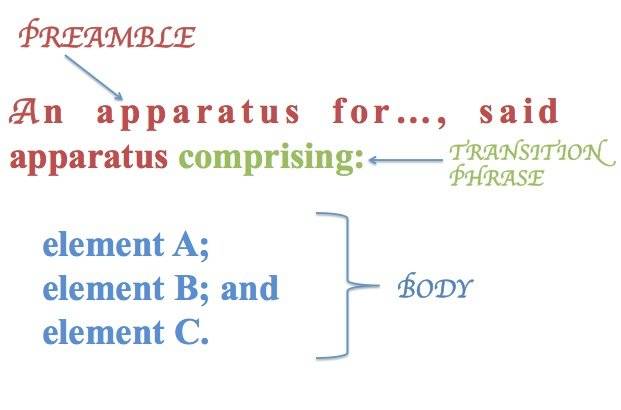This post was first published on July 16, 2014.
It would have been very well drummed into a patent professional, Mr. X, who has just started drafting a patent specification that “claims form the heart of a patent application,” or the “name of the game is claim,” and so on. Very few might agree with me if Mr. X has been told to carefully consider the words and/or features and/or the language used in the preamble, as improper drafting of preamble may limit the scope. Well, it is not Mr. X’s fault, nor the trainer’s fault. There are not many case laws or rather widely discussed case laws, elucidating or interpreting in detail the importance of a preamble as there are for definiteness, written description and other statutory requirements. In fact, in 1934 (in In Re Wolf), CCPA held that, “The preamble of a claim is introductory only and should not be considered as a limitation of the subject issue.”
While CCPA’s decision in In re Wolf is still held aloft like a banner, for more of a visual than cognitive effect, there are some case laws in which the federal circuit has touched upon or at certain times went into a little more detail on the importance/interpretation of preamble.
In Corning Glass works V. Sumitomo Elec U.S.A., Inc, 868 F.2d 1251 (Fed. Cir. 1989) in which preamble of the claim at issue recited “An optical waveguide,…” the court concluded that the claimed invention was for an optical waveguide and did not include a simple glass fiber. The court found it important that the inventors had not been seeking general improvements in conventional optical fibers but had been working for some time to solve a specific problem of optical communication system. Therefore, the court found that the scope of the claim and the scope of both infringing and anticipating devices, extended only to optical waveguides and not to optical fibers thus limiting the claim scope.
In Seachange International, Inc, V. C-Cor Inc, 413 F.3d 1361 (Fed Cir. 2005), in which preamble of the claim at issue recited “A method for redundantly storing data in a distributed computer system having at least three processor systems, each processor system comprising at least one central processing unit and at least one mass storage system, comprising the steps of …”, the court concluded that the apparatus elements mentioned in the preamble were essential elements and hence limited claim scope.
In Poly-America, L.P. V. GSE Lining Inc., 383 F.3d 1303 (Fed. Cir. 2004), in which the preamble of the claim at issue recited “A blown-film textured liner” the court found that the liner is a blown –film textured and hence the limitation was read into the claim while determining the scope.
In IMS Tech V. Hass Automation, Inc., 206 f.3d 1422 (Fed. Cir 2000), in which preamble of the claim at issue recited “A programmable microcomputer control apparatus for controlling the relative motion between a tool and a work piece ”
the issue was whether the term “control apparatus” required a control device separate from the machine tool. The court looked into the body of the claims, which claimed detailed sets of elements making up the control apparatus and hence, concluded that the preamble is non-limiting as it “merely gives descriptive name to the set of limitations in the body of the claim that completely set forth the invention.” Here the court considered a specific portion of a preamble rather than looking at the preamble as a whole for the analysis and conclusion.
In Marrin V. Griffin, 599 F.3d 1290 (Fed. Cir. 2010), in which preamble of the claim at issue recited “A scratch-off label for permitting a user to write thereon without use of a marking implement.” The court concluded that the preamble did not add limitation as the language only sets out an intended use, rather than the structure or purpose for structure.
As can be inferred from the aforementioned cases, preamble plays a very important role in claim construction and should be carefully drafted to avail broadest possible and/or varied scope of protection. The preamble is pivotal in determining (a) what prior art should be applied; and (b) whether a product/process is infringing the claim.
Further, though the principles mentioned are based on US Case law, they are very much applicable in the Indian context. Furthermore, considering the limitation to patent scope emphasized by the Supreme Court in the Novartis case, the role of preamble in limiting the scope of an invention becomes even more pertinent.
Following are some noteworthy points to be kept in mind while drafting a preamble,
- Of course, preamble should be directed to one of the statutory classes;
- Preamble can be considered as a limitation;
- Courts now consider as to whether the inventor intended the preamble to constitute a portion of the invention (in which case, preamble limits the scope) rather than simply determining as to what the inventor meant by a particular word;
- If features, devices, or process steps that are not themselves claimed are introduced in the preamble, then such elements surround the invention as context and do not become claim limitations;
- If the preamble only sets out the intended use rather than the structure, then the preamble does not add limitation to the scope; and
- If a preamble introduces the invention then such introduction does not add any limitations. However, if the preamble describes the invention, then such description is considered as limiting.



